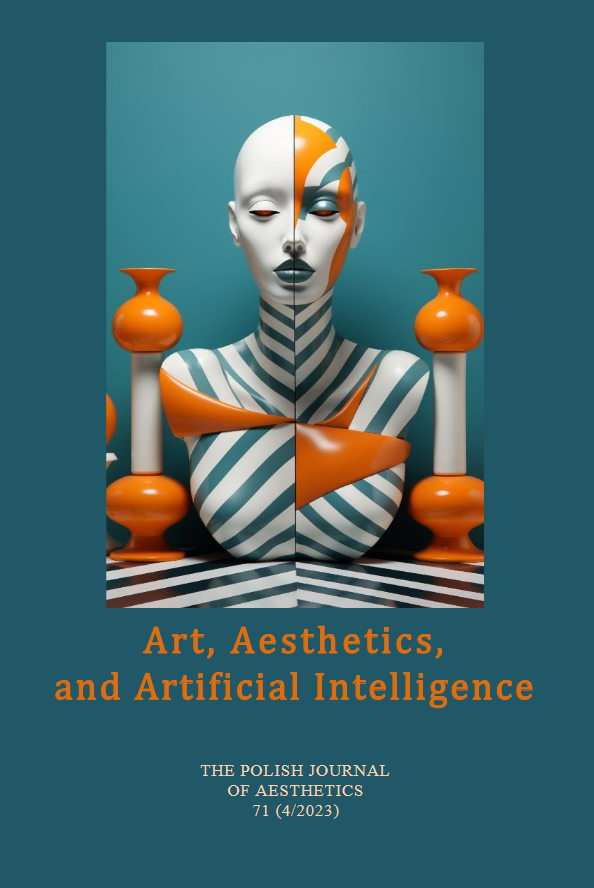Numer 71 (4/2023)
Art, Aesthetics, and Artificial Intelligence|
Spis treści
Strony
Pobierz
|
|||||
|
|
|||||
|
INFORMACJE O AUTORZE
Uniwersytet Jagielloński w Krakowie
|
|||||
|
Thorsten Botz-Bornstein
Do Computers Ruminate? On the Impossibility of “Thinking-Feeling” in AI Art
DOI: 10.19205/71.23.1
1 – 16
|
|||||
|
Słowa kluczowe Midjourney |Mondrian |Complexity |RandomnessStreszczenie Artists do not simply think and feel but incorporate feeling into their artistic thinking process or thinking into their feelings. The computer’s problem is neither that it does not think nor has any feelings (it might have some one day). The difference between a human drawing and a robot drawing is thus not that the former thinks and the latter does not. What matters is the “ruminating” aspect of creation that Wittgenstein alluded to, which Mondrian defined as thinking-feeling. I analyze the importance of randomness in human art and AI art. INFORMACJE O AUTORZE
Gulf University for Science and Technology, Kuwejt
|
|||||
|
Raquel Cascales
Interpreting AI-Generated Art: Arthur Danto’s Perspective on Intention, Authorship, and Creative Traditions in the Age of Artificial Intelligence
DOI: 10.19205/71.23.2
17 – 29
|
|||||
|
Słowa kluczowe Arthur Danto |AI-Generated Art |Authorship in AI-Generated Art |Intention in Art |Interpretation of AI ArtStreszczenie Arthur C. Danto did not live to witness the proliferation of AI in artistic creation. However, his philosophy of art offers key ideas about art that can provide an interesting perspective on artwork generated by artificial intelligence (AI). In this article, I analyze how his ideas about contemporary art, intention, interpretation, and authorship could be applied to the ongoing debate about AI and artistic creation. At the same time, it is also interesting to consider whether the incorporation of AI into artistic creation marks a new chapter in the narrative, which seems to have reached its end, or if it represents a significant rupture with past artistic traditions. INFORMACJE O AUTORZE
Universidad de Navarra, Hiszpania
|
|||||
|
Angélique Allaire,
Laurent Cervoni Magical Simulacra and Simulating Magic: A Baudrillardian Perspective on the Recognizing and Creating Magic Using Generative Artificial Intelligence
DOI: 10.19205/71.23.3
31 – 40
|
|||||
|
Słowa kluczowe magic |Baudrillard |AI |Performing ArtStreszczenie This essay focuses on the aesthetic experience of magical arts. The rise of artificial intelligence (AI) as a tool to decipher magic tricks or elaborate new tricks puts spectators and performers into question. While considering the current technical characteristics of neural networks and generative AI, we aim to show the impact of AI on magical arts using Jean Baudrillard’s hyperreality theory. Like any other technological innovation, AI poses new challenges to the magical arts. |
|||||
|
Tufan Acil
On the Legitimacy of AI-Generated Art: Exploring the Aspects of Creativity, Mediality and Human Agency
DOI: 10.19205/71.23.4
41 – 52
|
|||||
|
Słowa kluczowe AI-Generated Art |Computational Creativity |Mediality |Agency |AuthorshipStreszczenie Artificial Intelligence (AI) has revolutionized diverse fields, including art, raising questions about the authenticity and value of AI-generated artworks. This essay explores the legitimacy of AI art, examining whether these creations qualify as genuine art and how they integrate into the broader art historical context. It scrutinizes the theoretical debates surrounding the incorporation of AI applications in artistic creation, emphasizing the importance of understanding the creation and reception processes in evaluating the legitimacy of AI art. INFORMACJE O AUTORZE
Freie Universität, Berlin, Niemcy
|
|||||
|
|
|||||

